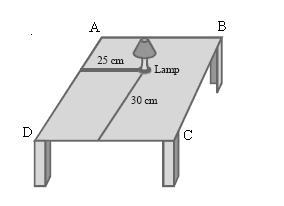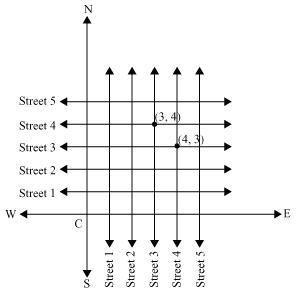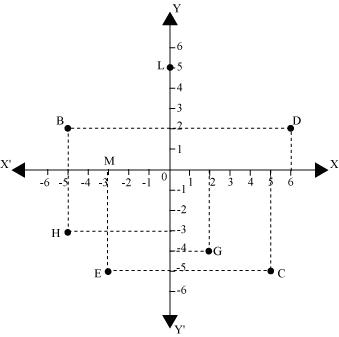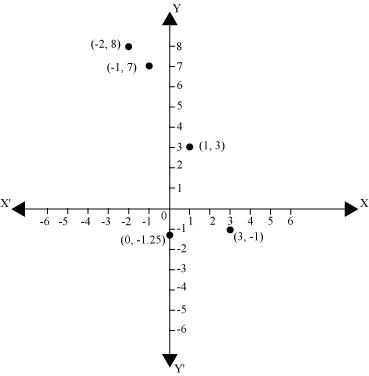NCERT Solution for Class 9 Mathematics Chapter 3 - Coordinate Geometry Page/Excercise 3.1
Question 1
How will you describe the position of a table lamp on study table to another person?
Solution 1
 Consider that the lamp is placed on the table. Here two references must be used to ascertain the position. Choose two adjacent edges DC and AD. Now draw perpendiculars on the two edges from the position of lamp and measure the lengths of these perpendiculars. Let the length of these perpendiculars be 30 cm and 25 cm respectively. Now the position of the lamp from the left edge (AD) is 25 cm and from the lower edge (DC) is 30 cm. Then the position of the table will be given by the points (25, 30). Concept Insight: Since there are two dimensions length and breadth of the table so two references are required to ascertain the position on the table. The point where the two edges of table can be taken as the references In this case we can have origin at any of the four corners. The perpendicular distance from the edges will give the position of lamp. Remember that (25, 30) and (30, 25) represent two different positions on the table.
Consider that the lamp is placed on the table. Here two references must be used to ascertain the position. Choose two adjacent edges DC and AD. Now draw perpendiculars on the two edges from the position of lamp and measure the lengths of these perpendiculars. Let the length of these perpendiculars be 30 cm and 25 cm respectively. Now the position of the lamp from the left edge (AD) is 25 cm and from the lower edge (DC) is 30 cm. Then the position of the table will be given by the points (25, 30). Concept Insight: Since there are two dimensions length and breadth of the table so two references are required to ascertain the position on the table. The point where the two edges of table can be taken as the references In this case we can have origin at any of the four corners. The perpendicular distance from the edges will give the position of lamp. Remember that (25, 30) and (30, 25) represent two different positions on the table.
Question 2
(Street Plan): A city has two main roads which cross each other at the centre of the city. These two roads are along the North-South direction and East-West direction.
All the other streets of the city run parallel to these roads and are 200 m apart there are about 5 streets in each direction. Using 1 cm = 200 m, draw a model of the city on your notebook Represent the roads/streets by single lines.
There are many cross-streets in your model. A particular cross-street is made by two streets, on running in the North-South direction and another in the East-West direction. Each cross street is referred to in the following manner: If the 2nd street running in the North-South direction and 5th in the East-West direction meet at some crossing then we will call this cross-street (2, 5). Using this convention, find:
(i) How many cross - streets can be referred to as (4, 3).
(ii) How many cross - streets can be referred to as (3, 4).
All the other streets of the city run parallel to these roads and are 200 m apart there are about 5 streets in each direction. Using 1 cm = 200 m, draw a model of the city on your notebook Represent the roads/streets by single lines.
There are many cross-streets in your model. A particular cross-street is made by two streets, on running in the North-South direction and another in the East-West direction. Each cross street is referred to in the following manner: If the 2nd street running in the North-South direction and 5th in the East-West direction meet at some crossing then we will call this cross-street (2, 5). Using this convention, find:
(i) How many cross - streets can be referred to as (4, 3).
(ii) How many cross - streets can be referred to as (3, 4).
Solution 2
 Both the cross- streets are marked in the above figure. We may observe that there is only one cross street which can be referred as (4, 3) and also only one which can be referred as (3, 4).
Both the cross- streets are marked in the above figure. We may observe that there is only one cross street which can be referred as (4, 3) and also only one which can be referred as (3, 4). Concept Insight: Consider north-south and west-east directions as two perpendicular axes. The point where the two axes intersect is called the origin. Drawing line parallel to x axis and y axis will give the five streets for each of the two given directions. Any point (x,y) on Cartesian plane represents a distance of x units from y axis and y units from x axis. Coordinate points (x,y) and (y,x) represents two different positions on a plane if
NCERT Solution for Class 9 Mathematics Chapter 3 - Coordinate Geometry Page/Excercise 3.2
Question 1
Write the answer of each of the following questions:
(i) What is the name of horizontal and the vertical lines drawn to determine the position of any point in the Cartesian place?
(ii) What is the name of each part of the plane formed by these two lines?
(iii) Write the name of point where these two lines intersect.
(i) What is the name of horizontal and the vertical lines drawn to determine the position of any point in the Cartesian place?
(ii) What is the name of each part of the plane formed by these two lines?
(iii) Write the name of point where these two lines intersect.
Solution 1
(i) The name of horizontal lines and vertical lines drawn to determine the position of any point in the Cartesian plane is x-axis and y axis respectively.
(ii) The name of each part of the plane formed by these two lines x-axis and y-axis is called as quadrants (one fourth part)
(iii) Name of the point where there two lines intersect is called as origin. Concept Insight: The question is based on factual knowledge remember that the horizontal and vertical lines drawn to determine the position are called x-axis and y axis respectively. The point where these two axes intersect is called the origin and these axes divide the coordinate plane into four parts called the 4 quadrants.
(ii) The name of each part of the plane formed by these two lines x-axis and y-axis is called as quadrants (one fourth part)
(iii) Name of the point where there two lines intersect is called as origin. Concept Insight: The question is based on factual knowledge remember that the horizontal and vertical lines drawn to determine the position are called x-axis and y axis respectively. The point where these two axes intersect is called the origin and these axes divide the coordinate plane into four parts called the 4 quadrants.
Question 2
See the given figure, and write the following: (i) The coordinates of B.
(ii) The coordinates of C.
(iii) The point identified by the coordinates (-3,-5).
(iv) The point identified by the coordinates (2,-4).
(v) The abscissa of the point D.
(vi) The ordinate of the point H.
(vii) The coordinates of the point L.
(viii) The coordinates of the point M 
(ii) The coordinates of C.
(iii) The point identified by the coordinates (-3,-5).
(iv) The point identified by the coordinates (2,-4).
(v) The abscissa of the point D.
(vi) The ordinate of the point H.
(vii) The coordinates of the point L.
(viii) The coordinates of the point M

Solution 2
(i) The x coordinate and y coordinate of point B are - 5 and 2 respectively. So the coordinates of point B is (- 5, 2)..
(ii) The x coordinate and y coordinate of point C are 5 and - 5 respectively. So the coordinates of point C is (5, - 5).
(iii) The point whose x coordinate and y coordinate are - 3 and - 5 respectively is point E.
(iv) The point whose x coordinate and the y coordinate are 2 and - 4 respectively is point G.
(v) The x coordinate of point D is 6. So, abscissa of the point D is 6.
(vi) The y coordinate of point H is - 3. So, ordinate of point H is - 3.
(vii) The x coordinate and y coordinate of point L are 0 and 5 respectively. So coordinates of point L is (0, 5).
(viii) The x coordinate and y coordinate of point M are - 3 and 0 respectively. So the coordinates of point M is (- 3, 0).
Concept Insight: For an ordered pair(x, y) in the coordinate plane, x is the distance of the point from Y axis also called the abscissa and y is the distance of the point from X axis also called the ordinate.
Remember that while locating the position of a point we always write x coordinate first and then y coordinate, the two coordinate points are always written in a closed bracket and are separated by a comma.
NCERT Solution for Class 9 Mathematics Chapter 3 - Coordinate Geometry Page/Excercise 3.3
Question 1
In which quadrant or on which axis do each of the points (-2,4), (3,-1), (-1,0), (1,2) and (-3,-5) lie? Verify your answer by locating them on the Cartesian plane.
Solution 1
(i) The point (-2,4) lies in IInd quadrant in Cartesian plane as for point (-2,4), x coordinate is negative and y coordinate is positive.
(ii) The point (3,-1) lies in IVth quadrant in Cartesian plane because for point (3,-1) , x coordinate is positive and y coordinate is negative.
(iii) The point (-1,0) lies on negative x-axis because for point (-1,0) the value of y coordinate is zero and the value of x coordinate is negative.
(iv) The point (1,2) lies in Ist quadrant as for point (1,2) both x and y are positive
(v) The point (-3,-5) lies in the IIIrd quadrant in Cartesian plane as for point (-3,-5) both x and y are negative.
Now let's plot each of the above points on the coordinate plane.
 Concept Insight:- The coordinates of a point are of the form (+,+) in the first quadrant, (-,+) in the second quadrant, (-.-) in the third quadrant and (+,-) in the fourth quadrant, where + denotes a positive real number and - denotes a negative real number. The coordinates of any point on the x axis has y coordinate as zero and for a point on y axis x coordinate is zero.
Concept Insight:- The coordinates of a point are of the form (+,+) in the first quadrant, (-,+) in the second quadrant, (-.-) in the third quadrant and (+,-) in the fourth quadrant, where + denotes a positive real number and - denotes a negative real number. The coordinates of any point on the x axis has y coordinate as zero and for a point on y axis x coordinate is zero.
For plotting the points let say (3,4) start from the origin first move 3 units along positive x axis and then from this marked position move 4 units along positive y axis.
(ii) The point (3,-1) lies in IVth quadrant in Cartesian plane because for point (3,-1) , x coordinate is positive and y coordinate is negative.
(iii) The point (-1,0) lies on negative x-axis because for point (-1,0) the value of y coordinate is zero and the value of x coordinate is negative.
(iv) The point (1,2) lies in Ist quadrant as for point (1,2) both x and y are positive
(v) The point (-3,-5) lies in the IIIrd quadrant in Cartesian plane as for point (-3,-5) both x and y are negative.
Now let's plot each of the above points on the coordinate plane.
 Concept Insight:- The coordinates of a point are of the form (+,+) in the first quadrant, (-,+) in the second quadrant, (-.-) in the third quadrant and (+,-) in the fourth quadrant, where + denotes a positive real number and - denotes a negative real number. The coordinates of any point on the x axis has y coordinate as zero and for a point on y axis x coordinate is zero.
Concept Insight:- The coordinates of a point are of the form (+,+) in the first quadrant, (-,+) in the second quadrant, (-.-) in the third quadrant and (+,-) in the fourth quadrant, where + denotes a positive real number and - denotes a negative real number. The coordinates of any point on the x axis has y coordinate as zero and for a point on y axis x coordinate is zero.For plotting the points let say (3,4) start from the origin first move 3 units along positive x axis and then from this marked position move 4 units along positive y axis.
Question 2
Plot the point (x, y) given in the following table on the plane, choosing suitable units of distance on the axis.
x
|
-2
|
-1
|
0
|
1
|
3
|
y
|
8
|
7
|
-1.25
|
3
|
-1
|
Solution 2
The given points are plotted on the Cartesian plane as below:  Concept Insight: The coordinates of a point (x,y) is such that its distance from y axis along the positive x axis is x units and the distance of the point from x axis along the y axis is y units. To locate such point we need to start from origin, count x units along x axis and then further move y units along y axis.
Concept Insight: The coordinates of a point (x,y) is such that its distance from y axis along the positive x axis is x units and the distance of the point from x axis along the y axis is y units. To locate such point we need to start from origin, count x units along x axis and then further move y units along y axis.
 Concept Insight: The coordinates of a point (x,y) is such that its distance from y axis along the positive x axis is x units and the distance of the point from x axis along the y axis is y units. To locate such point we need to start from origin, count x units along x axis and then further move y units along y axis.
Concept Insight: The coordinates of a point (x,y) is such that its distance from y axis along the positive x axis is x units and the distance of the point from x axis along the y axis is y units. To locate such point we need to start from origin, count x units along x axis and then further move y units along y axis.
No comments:
Post a Comment